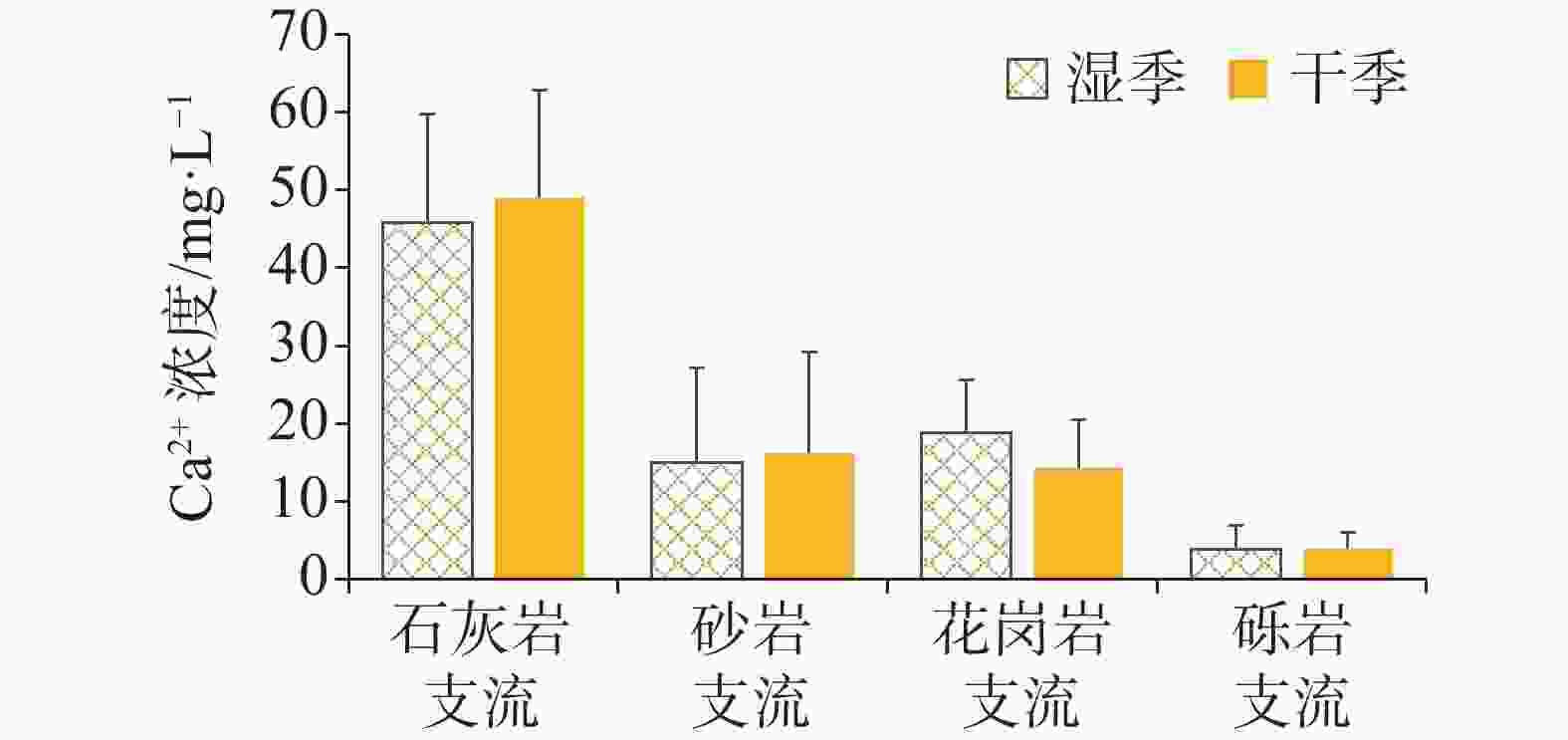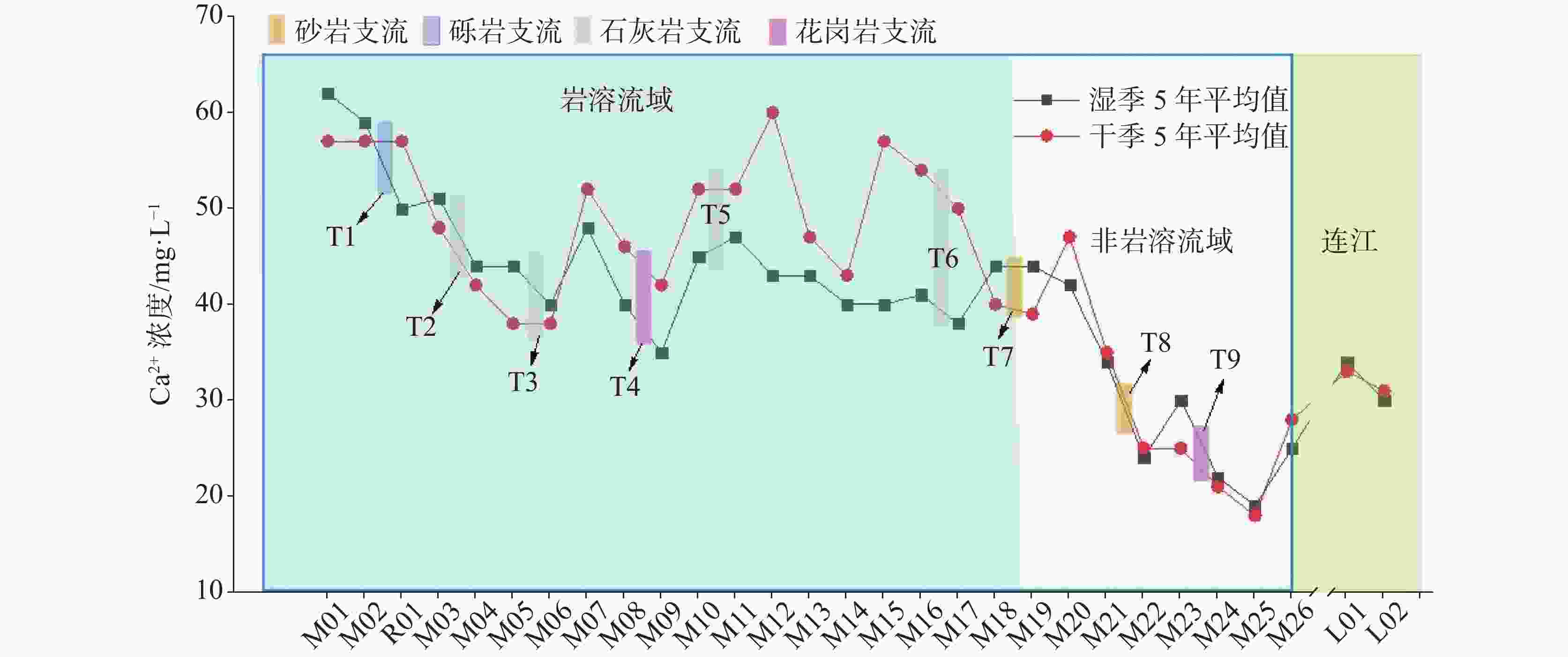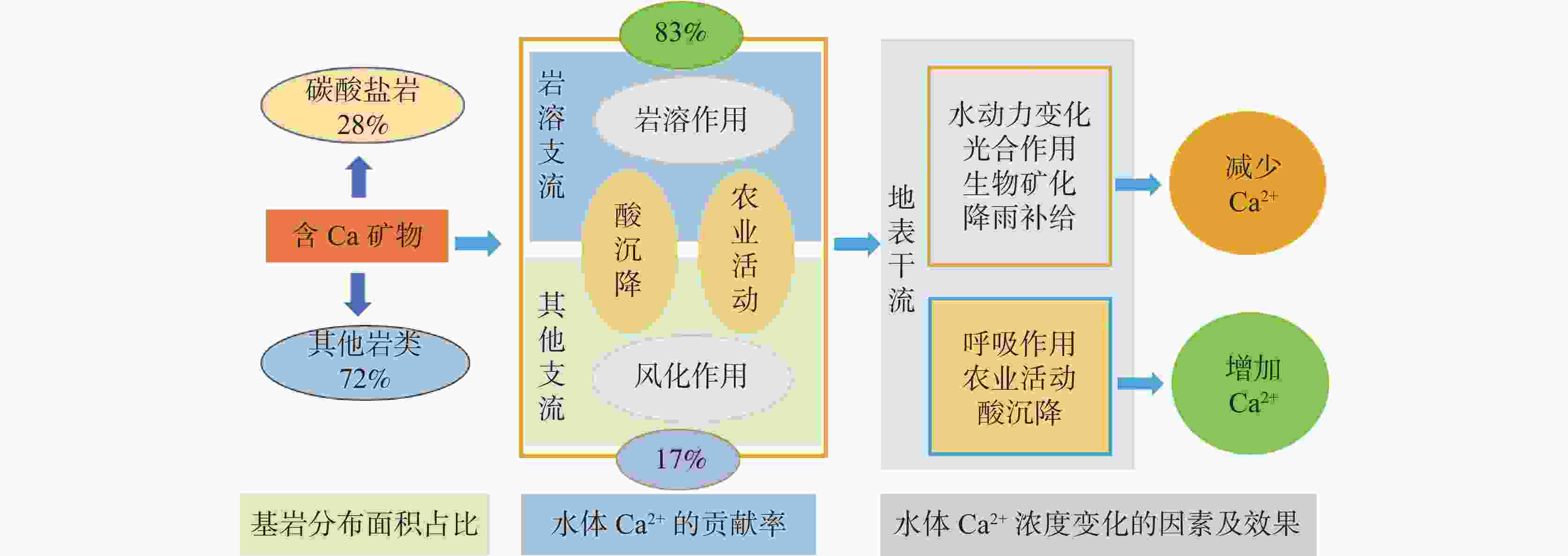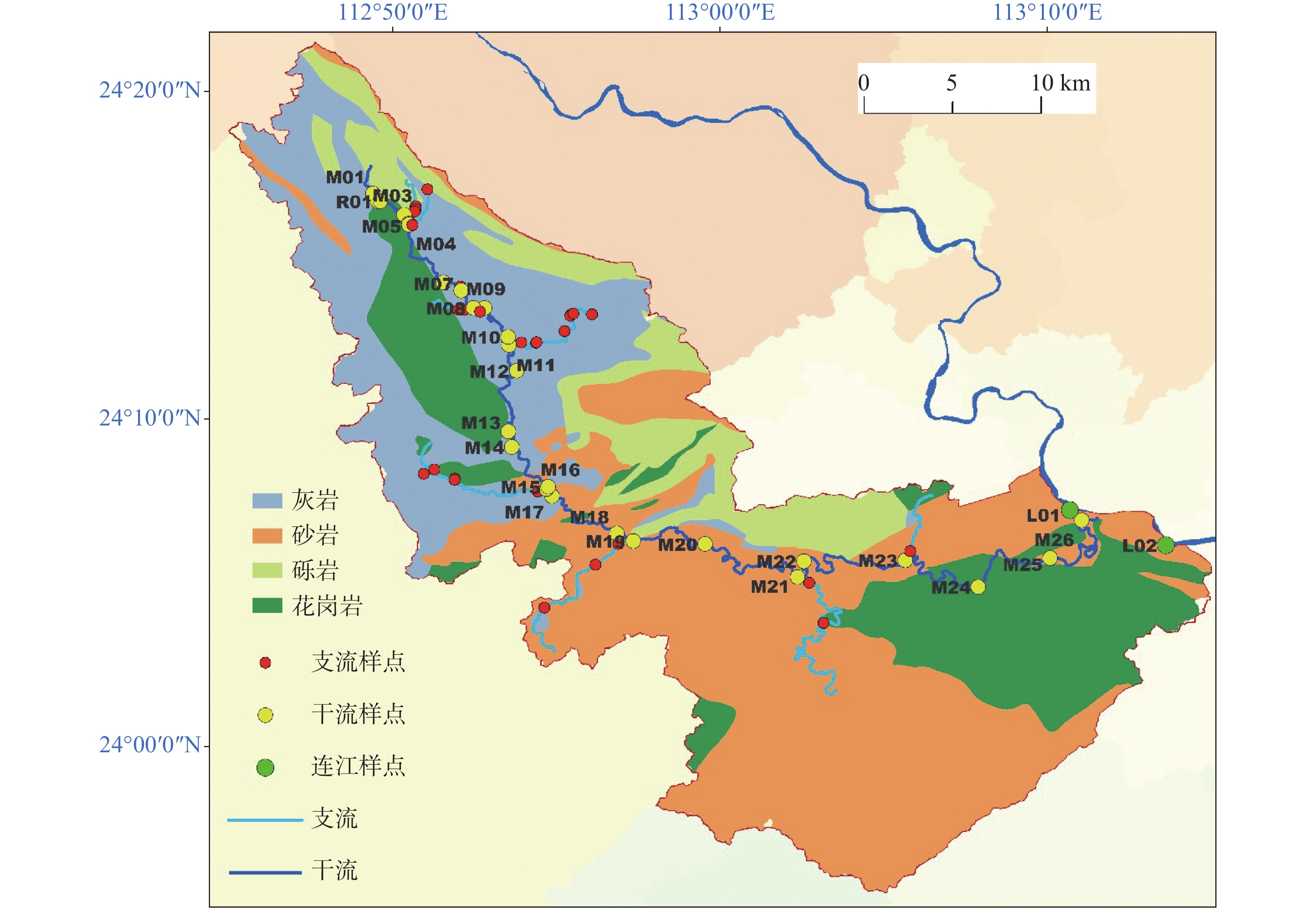Restriction of bedrock to calcium ion migration in the Shuibian river basin of northern Guangdong Province
-
摘要: 岩石风化是控制流域水体水化学特征的关键因素之一。为探索岩溶流域中不同基岩风化作用对地表水化学的影响,本文选择粤北典型岩溶流域(水边河)为研究对象,以水体[Ca2+]变化和钙迁移机制为研究主线,通过连续5年的系统调查及采样分析,揭示不同岩性风化对干流水体中Ca2+输送通量的贡献率和岩溶流域钙元素迁移的影响机理。结果表明:(1)不同基岩支流的水体[Ca2+]差异明显,特别是在干季,碳酸盐岩支流水体的[Ca2+]分别是花岗岩、砂岩和砾岩支流的3.8倍、4.7倍、14.9倍;(2)不同基岩支流汇入干流后,水化学变化具有滞后性,并且呈现季节性差异。其中,碳酸盐岩支流汇入后,干流水体的[Ca2+]会滞后升高,而其他支流会稀释[Ca2+],产生稀释作用,其效果在湿季比干季更明显;(3)通过统计分析得出,碳酸盐岩支流在流域土地面积占比为28%,而其对流域水体中[Ca2+]的贡献率达到83%,说明岩溶流域中碳酸盐岩的风化的制约着钙元素的迁移过程;(4)2016—2020年间,水边河向连江输送的钙通量平均值为7.2×104 t·a−1,其中,湿季平均输送量为5.8×104 t·a−1,干季平均为1.4×104 t·a−1;但岩溶水体中钙元素迁移不仅仅有水体溶解的Ca2+,还有沉积态钙迁移和水生生物的钙迁移过程,而农业活动及酸雨等过程可导致水体中[Ca2+]发生明显变化,因此,农业活动和酸雨等对钙迁移的影响需要多加关注。Abstract:
As a highly researched topic in hydrochemistry, rock weathering is a key factor in controlling the hydrochemical characteristics in a watershed. In karst watersheds, the weathering of carbonate rocks has a significant impact, leading to high levels of Ca2+ and Mg2+ cations, as well as ${\rm{HCO}}_3^{-}$ anions in water. In small non-karst watersheds, the dominant cations are Na+ or K+, with lower levels of Ca2+, and the main anions are Cl−, ${\rm{NO}}_3^{-}$, and others. Calcium is a vital element that plays a crucial role in the structure and functioning of karst ecosystems. Therefore, understanding the differences in Ca2+ concentrations and the interactions between external water and karst water is essential for accurately assessing the hydrochemical impact of bedrock on karst watersheds. The Shuibian river is a typical karst river located in the northern part of Guangdong Province, China. It spans a distance of 78 kilometers with an average gradient of 1.8‰. Its geographical coordinates are E112° 42' 13.511"–E113° 15' 3.730", and N24° 21' 28.22"–N23° 55' 34.61". The total area of its basin is approximately 857 square kilometers. The region where the river is situated falls under a subtropical monsoon climate, characterized by hot and humid summers. The prevailing warm and moist airflow comes from the south in summer. The average annual temperature ranges from 17.5 ℃ to 20.7 ℃, and the average annual precipitation is between 1,830–1,879 mm. The climate exhibits distinct wet and dry seasons. The wet season lasts from March to September, accounting for over 70% of the annual rainfall, while the dry season occurs from October to February, with less precipitation. The research area is predominantly composed of four different types of bedrock: sandstone, carbonate rock, granite, and conglomerate. To explore the impact of weathering processes of these various bedrock types on the chemical composition of surface water in karst regions, this study focuses on a representative karst watershed called the Shuibian river in northern Guangdong Province. The main objective of this study is to investigate the changes in calcium concentration ([Ca2+]) in the water body and understand the mechanisms of calcium migration within the watershed. To achieve this, a total of 28 sampling points were strategically placed along the main stream of the Shuibian river, with an additional 25 sampling points along 9 significant tributaries. These sampling points were spaced at an interval of approximately 3 kilometers covering a distance of 78 kilometers downstream from the upper reaches. Sampling had been conducted over a period of five years, from January 2016 to July 2020, encompassing both the dry season (January) and the wet season (July) each year. A total of 683 water samples were collected during these time periods. In addition to measuring water width, depth, and flow velocity at each sampling point, on-site measurements of conductivity, salinity, temperature, pH, and dissolved oxygen were also performed. By analyzing the data collected through this comprehensive five-year study, the aim is to determine the contribution of weathering processes of different rock types to the transport of calcium in the main stream water, as well as to understand the underlying mechanisms of calcium migration in the karst watershed. The results indicate as follows: (1) There are significant differences in the [Ca2+] levels of the tributaries with different types of bedrock, especially during the dry season. The [Ca2+] levels in the tributaries with carbonate rock are 3.8 times higher than those in tributaries with granite, 4.7 times higher than those in tributaries with sandstone, and 14.9 times higher than those in tributaries with conglomerate rock. (2) After the convergence of tributaries with different types of bedrock into the main stream, there is a delayed hydrochemical change that exhibits seasonal variations. Specifically, when the tributaries with carbonate rock converge, the [Ca2+] levels in the main stream water increase with a delay, while other tributaries dilute the [Ca2+] levels, resulting in a more pronounced dilution effect during the wet season compared to that during the dry season. (3) Through statistical analysis, it is found that the tributaries with carbonate rock account for 28% of the watershed land area, but they contribute 83% to the [Ca2+] levels in the watershed water. This indicates that the weathering of carbonate rock in karst watersheds plays a significant role in constraining the migration of calcium elements. (4) From 2016 to 2020, the average calcium flux transported by the Shuibian river to the Lianjiang river was 7.2×104 t·a−1. The average transport during the wet season was 5.8×104 t·a−1, while during the dry season, it was 1.4×104 t·a−1. However, it is important to note that the increase in soluble Ca2+ concentration caused by the dissolution of deposited CaCO3 in the water is approximately 30% of the total output. Therefore, the calcium migration process in the watershed water, which is transported in the form of CaCO3, also requires special attention. -
Key words:
- karst watershed /
- calcium migration flux /
- bedrock type /
- calcium ion concentration /
- allogenic water
-
表 1 水边河流域各类岩石汇流面积统计与地貌类型
Table 1. Area and landform of different types of bedrock in the Shuibian river basin
基岩
类型汇流面
积/km2占流域面
积比/%地形
地貌花岗岩 152 17 山地、丘陵 石灰岩 236 28 峰丛洼地和峰林平原 砾岩 101 12 山地 砂岩 368 43 山地和丘陵 合计 857 100 表 2 典型支流与干流汇合前后水体中[Ca2+]的变化(mg·L−1)
Table 2. Changes in [Ca2+] (mg·L−1) before and after the convergence of the tributaries with different types of bedrock into the mainstream
季节 样点位置 灰岩支流(T3) 砾岩支流(T1) 砂岩支流(T7) 花岗岩支流(T4) 连江干流(L01-L02) 干季 干流a 50.5±4.2 48.9±9.3 32.6±13.4 35.3±15.4 33.2±1.7 支流a 53.2±6.2 3.6±1.7 11.9±12.0 13.9±8.4 20.6±4.8 干流b 51.1±4.9 38.8±4.3 31.4±15.6 28.2±13.4 32.2±2.4 湿季 干流a 40.6±8.9 51.7±12.2 36.0±9.4 33.3±9.5 34.4±2.9 支流a 51.4±5.0 4.64±5.0 12.3±13.4 19.5±8.8 21.0±5.7 干流b 44.4±7.8 39.1±4.6 29.2±2.9 24.1±6.7 29.6±2.9 a:代表采样点位于支流或干流在交汇前的上游;b:代表采样点位于支流与干流交汇后的下游干流处。
a: the sampling points located in the upstream before the convergence of tributaries into the mainstream; b: the sampling points located in the downstream mainstream after the convergence of tributaries into the mainstream.表 3 水边河2016—2020年钙离子输送量的季节性变化
Table 3. Seasonal variations of calcium ion transport in the Shuibian river between 2016 and 2020
时间 降雨量
/mmCa2+
/mg·L−1沙坝最大流
量/m3·s−1输送量
/万t2016年干季 646.0 15.3 87.7 1.8 2016年湿季 1 904.5 19.3 308.3 11.0 2017年干季 238.0 22.4 36.3 1.0 2017年湿季 1 577.0 19.3 86.9 3.1 2018年干季 356.0 26.1 53.5 1.8 2018年湿季 1 407.5 18.5 80.6 2.6 2019年干季 137.0 28.0 28.6 1.0 2019年湿季 1 832.0 24.1 167.5 7.5 2020年干季 297.5 16.9 48.6 1.1 2020年湿季 1 617.5 17.3 138.5 4.4 -
[1] 陈率, 钟君, 李彩, 王万发, 徐森, 颜泽龙, 李思亮. 西南不同岩性混合小流域化学风化特征[J]. 生态学杂志, 2020, 39(4):1288-1299. doi: 10.13292/j.1000-4890.202004.008CHEN Shuai, ZHONG Jun, LI Cai, WANG Wanfa, XU Sen, YAN Zelong, LI Siliang. The chemical weathering characteristics of different lithologic mixed small watersheds in Southwest China[J]. Chinese Journal of Ecology, 2020, 39(4): 1288-1299. doi: 10.13292/j.1000-4890.202004.008 [2] Jiang Liguang, Yao Zhijun, Liu Zhaofei, Wang Rui, Wu Shanshan. Hydrochemistry and its controlling factors of rivers in the source region of the Yangtze River on the Tibetan plateau[J]. Journal of Geochemical Exploration, 2015, 155: 76-83. doi: 10.1016/j.gexplo.2015.04.009 [3] 杨慧, 陈家瑞, 梁建宏, 曹建华. 桂林丫吉岩溶区土壤有机碳和pH值与钙形态分布的关系初探[J]. 地质论坛, 2017, 63(4):1117-1126.YANG Hui, CHEN Jiarui, LIANG Jianhong, CAO Jianhua. Preliminary study on the relationship between soil organic carbon and ph value and calcium species in Yaji karst region, Guilin[J]. Geological review, 2017, 63(4): 1117-1126. [4] 母海东, 陈辉, 张志飞, 张斌. 全国1∶200 000区域水文地质图空间数据库[J]. 中国地质, 2021, 48(Suppl.2):124-138. doi: 10.12029/gc2021Z212MU Haidong, CHEN Hui, ZHANG Zhifei, ZHANG Bin. National 1∶200,000 regional hydrogeological map spatial database[J]. Geology in China, 2021, 48(Suppl.2): 124-138. doi: 10.12029/gc2021Z212 [5] Xiao Shizhen, Zeng Cheng, Lan Jiacheng, Di Yongning, He Jianghu, Xiao Hua, Huang Jialu. Hydrochemical characteristics and controlling factors of typical dolomite karst basin in humid subtropical zone[J]. Geofluids, 2021, 2021: 1-14. [6] 黄芬, 张春来, 杨慧, 曹建华, 李为, 周运超. 中国岩溶碳汇过程与效应研究成果及展望[J]. 中国地质调查, 2014, 1(3):57-66. doi: 10.19388/j.zgdzdc.2014.03.009HUANG Fen, ZHANG Chunlai, YANG Hui, CAO Jianhua, LI Wei, ZHOU Yunchao. Achievements and prospects in the study of karst carbon sink processes and effects in China[J]. Geological Survey of China, 2014, 1(3): 57-66. doi: 10.19388/j.zgdzdc.2014.03.009 [7] 张红波, 于奭, 何师意, 刘齐, 李幼玲. 桂林岩溶区大气降水的化学特征分析[J]. 中国岩溶, 2012, 31(3):289-295. doi: 10.3969/j.issn.1001-4810.2012.03.010ZHANG Hongbo, YU Shi, HE Shiyi, LIU Qi, LI Youling. Analysis on the chemical characteristics of the atmospheric precipitation in Guilin[J]. Carsologica Sinica, 2012, 31(3): 289-295. doi: 10.3969/j.issn.1001-4810.2012.03.010 [8] 曹建华, 蒋忠诚, 袁道先, 夏日元, 章程. 岩溶动力系统与全球变化研究进展[J]. 中国地质, 2017, 45(5):874-900. doi: 10.12029/gc20170504CAO Jianhua, JIANG Zhongcheng, YUAN Daoxian, XIA Riyuan, ZHANG Cheng. The progress in the study of the karst dynamic system and global changes in the past 30 years[J]. Geology in China, 2017, 45(5): 874-900. doi: 10.12029/gc20170504 [9] 曹建华, 周莉, 杨慧, 卢茜, 康志强. 桂林毛村岩溶区与碎屑岩区林下土壤碳迁移对比及岩溶碳汇效应研究[J]. 第四纪研究, 2011, 31(3):431-437. doi: 10.3969/j.issn.1001-7410.2011.03.05CAO Jianhua, ZHOU Li, YANG Hui, LU Qian, KANG Zhiqiang. Comparison of carbon transfer between forest soils in karst and clasolite areas and the karst carbon sink effect in Maocun village of Gunlin[J]. Quaternary Sciences, 2011, 31(3): 431-437. doi: 10.3969/j.issn.1001-7410.2011.03.05 [10] 曹建华, 袁道先, 杨慧, 黄芬, 朱同彬, 梁建宏, 周孟夏, 罗劬侃, 吴夏. 岩溶生态系统中的植物[J]. 中国岩溶, 2022, 41(3):365-377.CAO Jianhua, YUAN Daoxian, YANG Hui, HUANG Fen, ZHU Tongbin, LIANG Jianhong, ZHOU Mengxia, LUO Qukan, WU Xia. Karst ecosystem and its plants[J]. Carsologica Sinica, 2022, 41(3): 365-377. [11] 蒲俊兵, 蒋忠诚, 袁道先, 章程. 岩石风化碳汇研究进展:基于IPCC第五次气候变化评估报告的分析[J]. 地球科学进展, 2015, 30(10):1081-1090.PU Junbing, JIANG Zhongcheng, YUAN Daoxian, ZHANG Cheng. Some opinions on rock-weathering-related carbon sinks from the IPCC fifth assessment report[J]. Advances in Earth Science, 2015, 30(10): 1081-1090. [12] 张世殊, 冉从彦, 许模, 郭建平. 开茂水库岩溶地下水水文地球化学特征研究[J]. 地下水, 2020, 42(5):17-20. doi: 10.19807/j.cnki.DXS.2020-05-005ZHANG Shishu, RAN Congyan, XU Mo, GUO Jianping. Hydrochemical characteristics of karst water in Kaimao reservoir[J]. Ground Water, 2020, 42(5): 17-20. doi: 10.19807/j.cnki.DXS.2020-05-005 [13] Bibiano Luvina, Garfias Jaime, Acebo Hilario Jesus Llanos. Groundwater hydrochemistry and natural softening processes in karstic systems[J]. Tecnologia y Ciencias del Agua, 2015, 6(3): 57-78. [14] 章程, 肖琼. 桂林漓江水体溶解无机碳迁移与水生光合碳固定研究[J]. 中国岩溶, 2021, 40(4):555-564.ZHANG Cheng, XIAO Qiong. Study on dissolved inorganic carbon migration and aquatic photosynthesis sequestration in Lijiang river, Guilin[J]. Carsologica Sinica, 2021, 40(4): 555-564. [15] 王培, 曹建华, 邵景力. 典型水生植物对岩溶水生生态系统无机碳稳定性影响研究[J]. 地球学报, 2017, 38(Suppl.1):51-54. doi: 10.3975/cagsb.2017.s1.14WANG Pei, CAO Jianhua, SHAO Jingli. Effects of typical aquatic plants on the stability of inorganic carbon in karst aquatic ecosystem[J]. Acta Geoscientica Sinica, 2017, 38(Suppl.1): 51-54. doi: 10.3975/cagsb.2017.s1.14 [16] Nimick David A, Gammons Christopher H, Parker Steve R. Diel biogeochemical processes and their effect on the aqueous chemistry of streams: A review[J]. Chemical Geology, 2011, 283(1-2): 3-17. [17] 黄芬, 唐伟, 汪进良, 曹建华, 殷建军. 外源水对岩溶碳汇的影响:以桂林毛村地下河为例[J]. 中国岩溶, 2011, 30(4):417-421. doi: 10.3969/j.issn.1001-4810.2011.04.011HUANG Fen, TANG Wei, WANG Jinliang, CAO Jianhua, YIN Jianjun. The influence of allogenic water on karst carbon sink: A case study in the Maocun subterranean river in Guilin[J]. Carsologica Sinica, 2011, 30(4): 417-421. doi: 10.3969/j.issn.1001-4810.2011.04.011 [18] 吕琳, 李伟, 刘元晴, 宋绵, 邓启军, 郑一迪. 太行山北段金龙洞岩溶泉水化学及同位素动态特征[J]. 中国岩溶, 2023, 42(1):149-160,181. doi: 10.11932/karst20230111LYU Lin, LI Wei, LIU Yuanqing, SONG Mian, DENG Qijun, ZHENG Yidi. Dynamic analysis of hydrochemistry and isotope of the karst spring of Jinlong cave in the northern section of Taihang mountains[J]. Carsologica Sinica, 2023, 42(1): 149-160,181. doi: 10.11932/karst20230111 [19] 蒋忠诚, 袁道先, 曹建华, 覃小群, 何师意, 章程. 中国岩溶碳汇潜力研究[J]. 地球学报, 2012, 33(2):129-134.JIANG Zhongcheng, YUAN Daoxian, CAO Jianhua, QIN Xiaoqun, HE Shiyi, ZHANG Cheng. A Study of carbon sink capacity of karst processes in China[J]. Acta Geoscientica Sinica, 2012, 33(2): 129-134. [20] 黄芬, 吴夏, 杨慧, 张春来, 曹建华. 桂林毛村地下河流域岩溶关键带碳循环研究[J]. 广西科学, 2018, 25(5):515-523. doi: 10.13656/j.cnki.gxkx.20181008.001HUANG Fen, WU Xia, YANG Hui, ZHANG Chunlai, CAO Jianhua. Study on carbon cycle of karst critical zone of Maocun subterranean river basin of Guilin[J]. Guangxi Sciences, 2018, 25(5): 515-523. doi: 10.13656/j.cnki.gxkx.20181008.001 [21] 刘再华. 外源水对灰岩和白云岩的侵蚀速率野外试验研究:以桂林尧山为例[J]. 中国岩溶, 2000, 19(1):1-6.LIU Zaihua. Field experimental research on the corrosion kinetics of limestone and dolomite in allogenic water: Case from Yaoshan mountain, Guilin[J]. Carsologica Sinica, 2000, 19(1): 1-6. [22] 周彬, 罗朝晖, 周宏, 刘建. 香溪河岩溶流域水文地球化学特征分析[J]. 安全与环境工程, 2016, 23(5):7-12, 42. doi: 10.13578/j.cnki.issn.1671-1556.2016.05.002ZHOU Bin, LUO Zhaohui, ZHOU Hong, LIU Jian. Analysis of hydrogeochemical characteristics of karst basin in Xiangxi river[J]. Safety and Environmental Engineering, 2016, 23(5): 7-12, 42. doi: 10.13578/j.cnki.issn.1671-1556.2016.05.002 [23] 袁建飞, 邓国仕, 徐芬, 唐业旗, 李鹏岳. 毕节市北部岩溶地下水水文地球化学特征[J]. 水文地质工程地质, 2016, 43(1):12-21. doi: 10.16030/j.cnki.issn.1000-3665.2016.01.03YUAN Jianfei, DENG Guoshi, XU Fen, TANG Yeqi, LI Pengyue. Hydrogeochemical characteristics of karst groundwater in the northern part of the city of Bijie[J]. Hydrogeology & Engineering Geology, 2016, 43(1): 12-21. doi: 10.16030/j.cnki.issn.1000-3665.2016.01.03 [24] 杜文越, 王琪, 蒲俊兵, 于奭. 漓江流域丰水期外源酸对岩溶化学风化碳汇的影响[J]. 地球学报, 2022, 43(4):449-460.DU Wenyue, WANG Qi, PU Junbing, YU Shi. Effect of exogenous acids on the karst chemical weathering and carbon sink in Lijiang river during the wet season[J]. Acta Geoscientica Sinica, 2022, 43(4): 449-460. [25] 吴雨珩, 曾发明, 魏兴琥, 刘淑娟, 黄金国. 粤北岩溶区土壤酸化的空间分异特征研究[J]. 中国岩溶, 2022, 41(5):784-795. doi: 10.11932/karst20220510WU Yuheng, ZENG Faming, WEI Xinghu, LIU Shujuan, HUANG Jinguo. Spatial variation of soil acidification in the karst area of northern Guangdong: A case in peak cluster depression and karst trough valley landforms[J]. Carsologica Sinica, 2022, 41(5): 784-795. doi: 10.11932/karst20220510 -




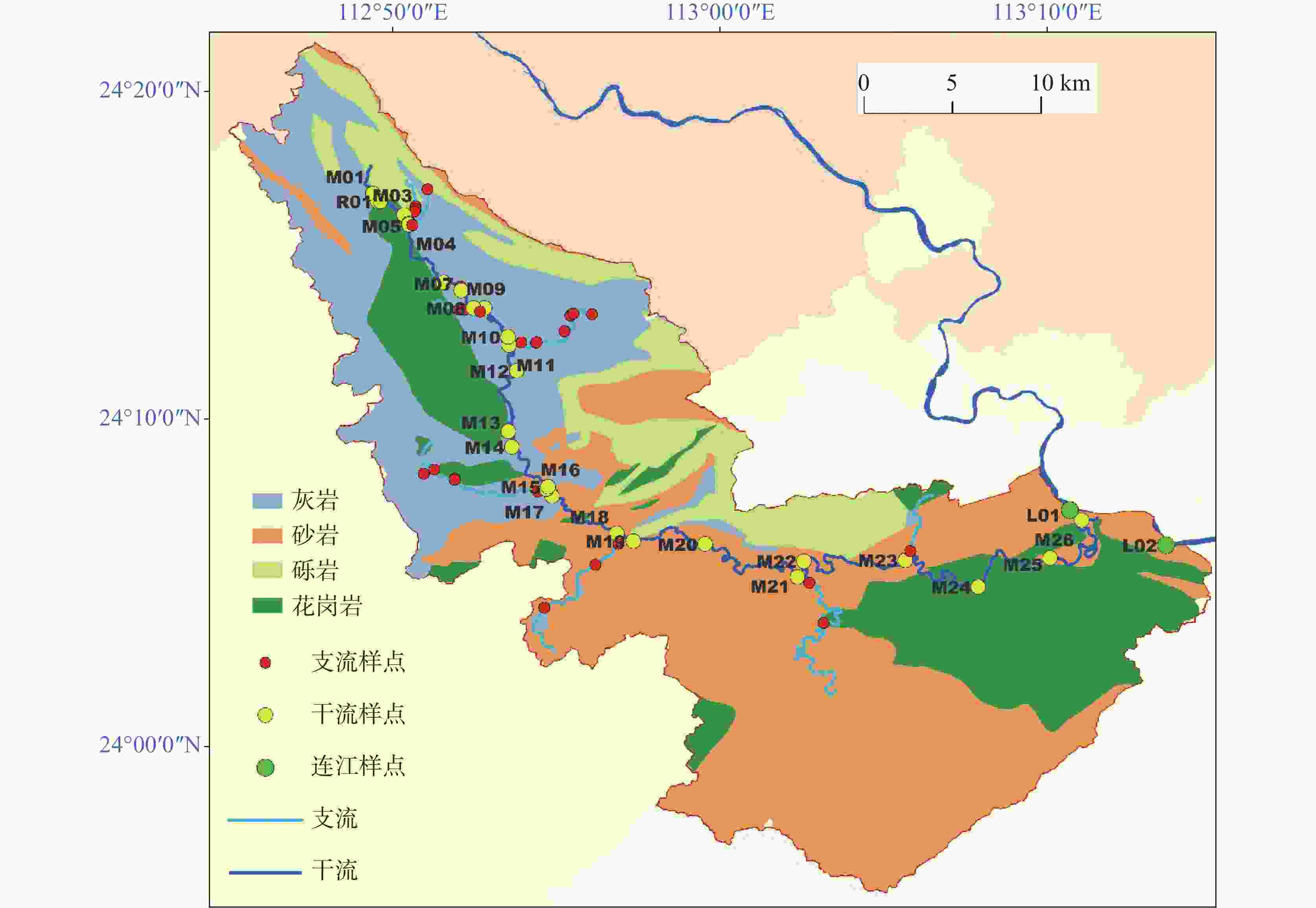
 下载:
下载:
